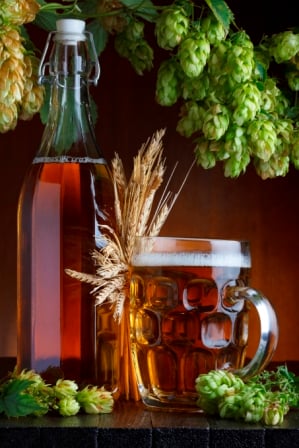This week I take a look at IBU levels in beer, how they are estimated and how they are measured in ways that may surprise most brewers! This article started with a question from a brewer who simply asked “Is the IBU estimate produced by BeerSmith a measure of IBUs before fermentation or in the finished beer?” The answer might surprise you…
Hop IBU Estimation for Beer Recipe Design
Many of you are familiar with the IBU estimates which are done in BeerSmith as well as a variety of other spreadsheets and software to assist brewers in getting the correct bitterness levels in beer. Three main estimation method are used: Tinseth, Garetz and Rager. As I covered in an earlier article, the basic formula for bitterness in all of these is:
IBUS = UTILIZATION_FACTOR * ALPHA% * HOP_WEIGHT / WORT_VOLUME
The only thing that differs between the three equations is how the utilization factor is calculated. All of the equations use the boil time and gravity of the boil to estimate the utilization. Each of the formulas gives us an IBU number for each hop addition and we then total those up to get an overall IBU number for the recipe. Whirlpool hop IBUs can also be calculated using a few other factors and added in.
What Does the IBU Estimate Mean?
Setting aside for a moment the subtle differences between the Tinseth, Garetz and Rager equations, what does the hop IBU number actually mean? Is the IBU estimate an estimate of IBUs in the finished beer or is it a measure of IBUs pre-fermentation?
After asking a few famous home brewers and not getting a satisfactory answer, I decided to go to the source. Way back in episode 9 of the BeerSmith podcast, I had Glenn Tinseth (author of the Tinseth equation) on as a guest and I happened to still have his email. So I asked Glenn how he sampled the IBUs used to develop the equation.
Not surprisingly he told me that the measurements were taken pre-fermentation. So his equation, which is probably the most widely used, is an estimate of IBUs in the wort prior to fermentation.
It is well documented that there is some loss of isomerized alpha acids during fermentation, so the finished beer IBU will almost always be lower than the pre-fermentation (estimated) IBUs.
What About the IBUs in the Style Guides?
So given that IBU estimates produced by every piece of software on the planet is pre-fermentation, what about the IBUs listed in the style guides? Once again I decided to go to the source and asked Gordon Strong, President of the BJCP which is arguably the most widely used beer style guide in homebrewing worldwide.
Gordon told me quite simply that the style guides were done based on the estimated and not measured IBUs. This is good as at least it provides some consistency between designing a recipe and matching it up with the style guide, but it is an interesting piece of trivia that the finished beer is likely not going to match the IBU levels listed in the style guide if you measure it and in all likelihood will be much lower.
Where Does this Leave Us?
At first I was quite concerned that IBU estimates are seemingly disconnected from the measured IBU levels in a finished beer. In fact, unless a craft brewery measures their IBU levels consistently, most of the IBU levels quoted for craft beer and homebrew are in all likelihood really the estimated IBU number and not the actual.
In reality, however, the situation is not as bad as it sounds. If you look at the estimated IBUs as a tool for designing beer and not an absolute measure of final bitterness, it all starts to make more sense. Various software, style guides, and the industry all use estimated IBUs by convention to express the bitterness level in the beer.
Because everyone has adopted the estimated IBU convention, you can safely use the estimated IBUs to design your beer, adjust bitterness levels and create great beer. You just need to understand if you actually send your beer off to a lab to measure the actual IBUs you will probably get a different result that predicted.
Thanks for joining me on the BeerSmith Home Brewing Blog. Be sure to sign up for my newsletter or my podcast (also on itunes…and youtube) for more great tips on homebrewing.

Brad,
Another great article, thanks for posting it. I fully agree, calculated IBU is a figure of merit, to be compared to similar beers, during the design phase for a beer. Then we can adjust it, if we think the beer came out too bitter, or not bitter enough. Absolute IBU level is of little concern to me. Thanks again, and keep up the great work, see you in Pittsburgh, next June! Brew On!
Dave King
Very interesting and informative blog post! But it does beg the question: When a beer sample is tested for IBUs in a lab, how is that done? More specifically, WHAT does the lab actually measure and how does that relate to what I perceive on the back of my tongue when I sip a glass of beer? Also, how much difference is there between the three estimation methods, and has anyone ever tested them against lab-measured values to see how they stack up?